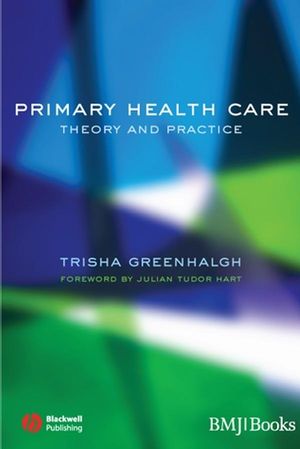Primary Health Care: Theory and PracticeISBN: 978-0-7279-1785-0
Paperback
338 pages
September 2007, BMJ Books
 This is a Print-on-Demand title. It will be printed specifically to fill your order. Please allow an additional 10-15 days delivery time. The book is not returnable.
|
||||||
Preface.
Foreword.
1 Introduction.
1.1 What is primary (health) care?.
1.2 What is academic study?.
1.3 What are theories – and why do we need them?.
2 The ‘ologies’ (underpinning academic disciplines) of.
primary health care.
2.1 Biomedical sciences.
2.2 Epidemiology.
2.3 Psychology.
2.4 Sociology.
2.5 Anthropology.
2.6 Literary theory.
2.7 Philosophy and ethics.
2.8 Pedagogy.
3 Research methods for primary health care.
3.1 What is good research in primary health care?.
3.2 Qualitative research.
3.3 Quantitative research.
3.4 Questionnaire research.
3.5 Participatory (‘action’) research.
3.6 Research data – and analysing it.
3.7 Critical appraisal of published research papers.
3.8 Systematic review.
3.9 Multi-level approaches to primary care problems.
4 The person who is ill.
4.1 The sick role.
4.2 The illness narrative.
4.3 Lifestyle choices and ‘changing behaviour’.
4.4 Self-management.
4.5 Health literacy.
5 The primary care clinician.
5.1 The role of the generalist.
5.2 Clinical method I: rationalism and Bayes’ theorem.
5.3 Clinical method II: humanism and intuition.
5.4 Clinical method III: the patient-centred method.
5.5 Influencing clinicians’ behaviour.
5.6 The ‘good’ clinician.
6 The clinical interaction.
6.1 The clinical interaction I: a psychological perspective.
6.2 The clinical interaction II: a sociolinguistic perspective.
6.3 The clinical interaction III: a psychodynamic perspective.
6.4 The clinical interaction IV: a literary perspective.
6.5 The interpreted consultation.
7 The family – or lack of one.
7.1 Family structure in the late modern world.
7.2 The mother–child relationship (or will any significant other.
do these days?).
7.3 Illness in the family – nature, nurture and culture.
7.4 Homelessness.
8 The population.
8.1 Describing disease in populations.
8.2 Explaining the ‘causes’ of disease.
8.3 Detecting disease in populations.
8.4 ‘Risk’: an epidemiological can of worms?.
9 The community.
9.1 Unpacking health inequalities I: deprivation.
9.2 Unpacking health inequalities II: social networks and social.
capital.
9.3 Unpacking health inequalities III: life course epidemiology.
and ‘risk regulators’.
9.4 Developing healthy communities I: community oriented.
primary care.
9.5 Developing healthy communities II: participatory.
approaches.
10 Complex problems in a complex system.
10.1 Illness in the twenty-first century: chronicity, comorbidity.
and the need for coordination.
10.2 Coordinating care across professional and organisational.
boundaries.
10.3 The electronic patient record: a road map for seamless.
care?.
10.4 The end of an era?.
11 Quality.
11.1 Defining and measuring quality.
11.2 A rational biomedical perspective: evidence-based targets,.
planned change and criterion-based audit.
11.3 A narrative perspective: significant event audit.
11.4 A social learning perspective: peer review groups and.
quality circles.
11.5 A phenomenological perspective: the patient as mystery.
shopper.
11.6 A sociological perspective: Quality Team Development as.
organisational sensemaking.
Index



